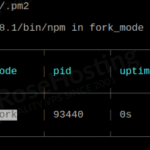Late this year, Chinese tech giant Xiaomi unveiled CyberDog: a quadrupedal, experimental, open-source robot that the firm claims will improve the robot development environment and promote the development of the robot industry. Today, Canonical dives into the specifications of this four legged robot and discover how Ubuntu is helping the device become an open source technological platform.
Xiaomi has a clear vision for its product. As Huang Changjiang, PM at Xiaomi, explains, “CyberDog is developers’ technological partner from the future. It equips inhouse-made high-performance servo motors, high computing ability, with built-in AI for visual detection system and voice interaction system, supporting a variety of bionic motion gestures.”
CyberDog; features and benefits of the four legged robot
The CyberDog project is dedicated to building four legged robot development platforms. With the open-source development environment, Xiaomi aims to build and leverage community contribution and maintenance. As a result, the platform will benefit from a rich ecosystem of applications and compatibility with technologies used in the robotics domain. The ultimate goal for Xiaomi is to increase its technological leadership in the robotics industry. In return, Xiaomi is making available an affordable, state-of-the-art and easy-to-use robotics platform.
Price
Let’s start with the price. Spot, the quadruped robot developed by Boston Dynamics, is the main competitor of CyberDog. It comes at a base price of $74,000 USD. Conversely, the base price for CyberDog is $1,540 USD. This affordable price will allow many research institutes and startups to build and accelerate the development of robotics applications for four legged robots.
In-house development
But CyberDog has not sacrificed quality to attain that low price. While affordable, CyberDog is not a cheap robot. CyberDog’s in-house high-performance servo motors provide a max torque of 32Nm, 220rpm, and 3.2 m/s speed, which ensures the robot’s high torque and high-speed, and agile response. The powerful performance support allows CyberDog to make various complex motions easily, such as backflips and other difficult movements.
Perception and awareness
CyberDog can even derive biologically intuitive interactive functions, as well as environmental perception and analysis capabilities. Thanks to its 11 high-precision sensors that are always on standby, it can detect any minor changes in the environment. With a built-in super perception visual detection system, CyberDog is capable of autonomous recognition, SLAM mapping, and navigation and obstacle avoidance functions.
“Xiaomi also uses human behaviour detection technology and pedestrian recognition technology,” adds Huang. “The use of face recognition technology makes CyberDog adopt pet-like features, such as following the owner in a wide-open space, creating a navigation map through algorithms, and planning the optimal route to the next target point automatically.”
Unlocking the robotics ecosystem with Ubuntu
CyberDog’s operating system is Ubuntu 18.04. This is not surprising for robotics developers. Xiaomi knows the risks of running technologically isolated projects based on proprietary technology. As Huang explains, “Open Source is core for CyberDog, it ensures compatibility and growth. It enables developers to have the freedom to push boundaries, and that is what CyberDog was meant to do.”
Support for robotics software stacks
For more than a decade, Ubuntu has supported the robotics community, providing a stable foundation for several open-source robotics projects. Ubuntu is the Tier 1 OS for ROS, natively supporting both ROS 1 and ROS 2 distributions. It also supports the rich software stack of drone developers, including PX4. On the automotive side, Ubuntu is also the go-to OS for open source projects, and is used in Dallara AV-21 racecars. ROS is a part of the rich open source infrastructure that Ubuntu unlocks for CyberDog.
“We believe in the present and future of ROS 2. Its rich set of libraries and tools provides market readiness to robotics developers,” says Huang. “CyberDog is providing the platform to leverage this in the best hardware. ROS deployment on Ubuntu becomes easier and makes secondary development more friendly. We aim to unlock this rich ecosystem of applications and algorithms for CyberDog.“
Secure design
CyberDog also benefits from Ubuntu secure design. Since its inception in 2004, Ubuntu has been built on a foundation of enterprise-grade, industry leading security practices. From its toolchain and the suite of packages it uses, to its industry-standard certifications and update mechanisms, Canonical never stops working to keep Ubuntu at the forefront of safety and reliability. CyberDog leverages this robust infrastructure to provide a four legged robot, which will receive security updates for the lifetime of the device.
Powering the future together
Xiaomi released 1,000 CyberDog units, encouraging engineers and robotic enthusiasts to jointly explore its immense possibility. The company will also set up the “Xiaomi Open Source Community” to constantly share progress and results with developers around the world.
This effort contributes to the popularization of four legged robots. Startups, research institutes and universities around the world are now exploring how and where such machines can be deployed effectively. CyberDog’s affordability and open source nature accelerate the research for new use-cases. We’re already seeing four legged robots exploring mines or helping first responders in natural disasters. These devices have also found uses in the construction industry or helping with industrial inspections, where terrain manoeuvrability poses a challenge. More and more applications are being discovered every day, thanks to this collaborative work.
Meanwhile, Ubuntu unlocks a rich ecosystem of open source tools and libraries, including ROS, to accelerate this development process. By choosing to work on Ubuntu, Xiaomi equips CyberDog with an unparalleled development environment. And we cannot wait to see what the industry builds on top of it.
- Want to unlock all of Ubuntu’s infrastructure for your robotics devices? Let’s do it together.
- Want to know how other robotics companies have leveraged Ubuntu and our robotics tools? Have a look at SmartDrone case study
- Want to learn more about Ubuntu Core? Install Ubuntu Core in your Raspberry Pi.



